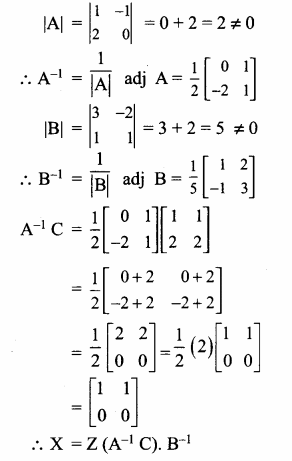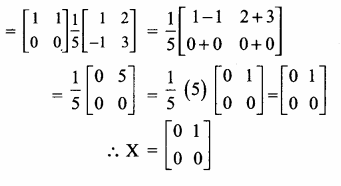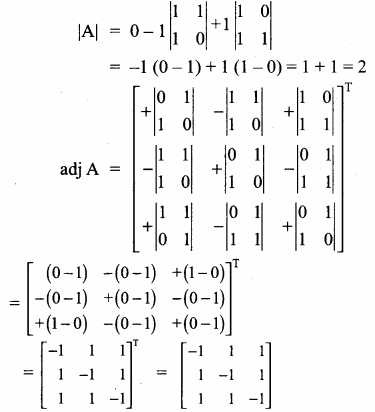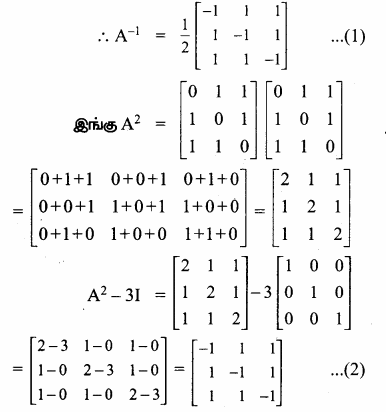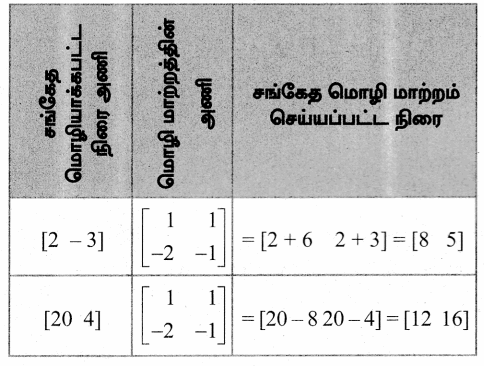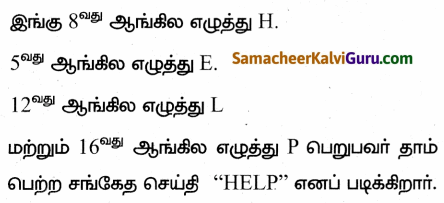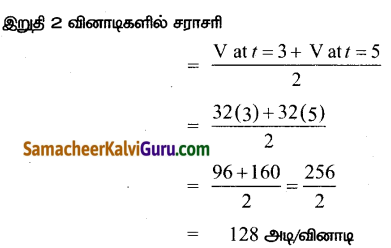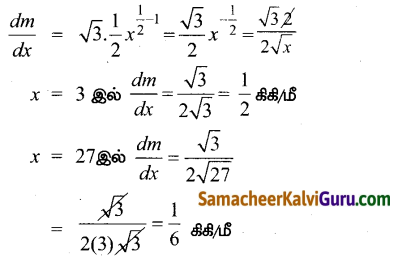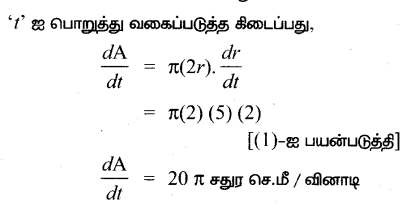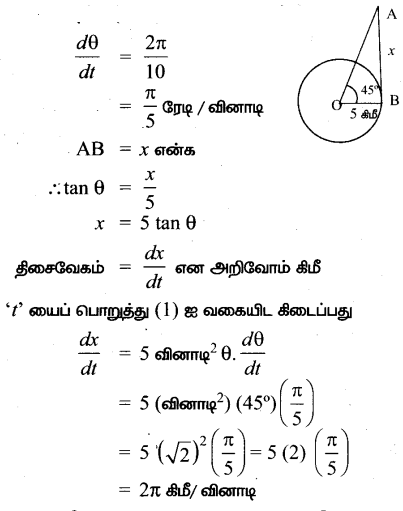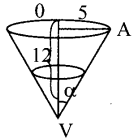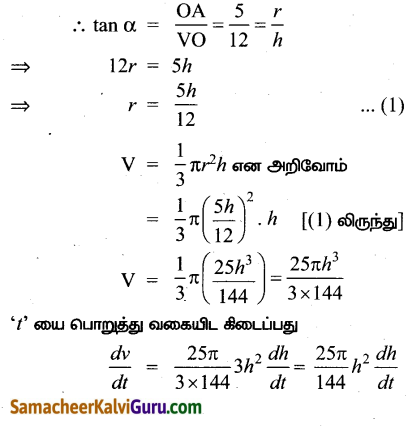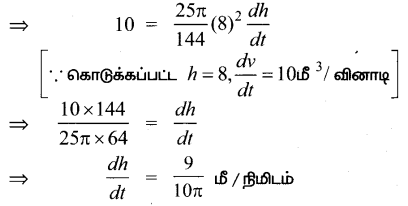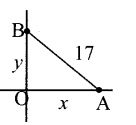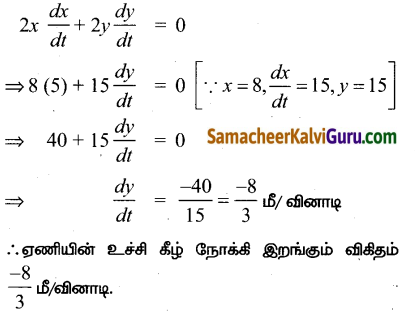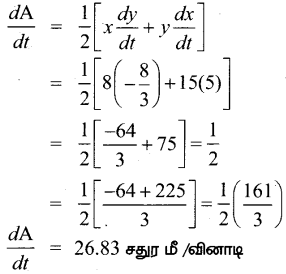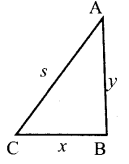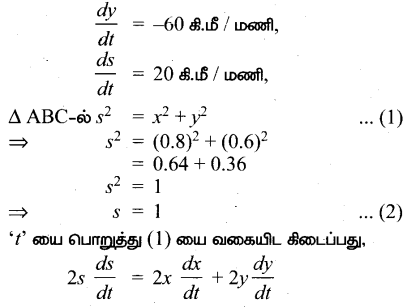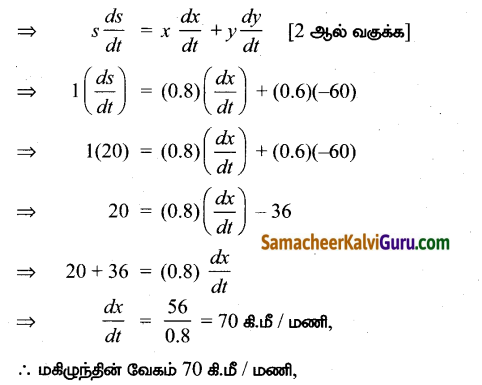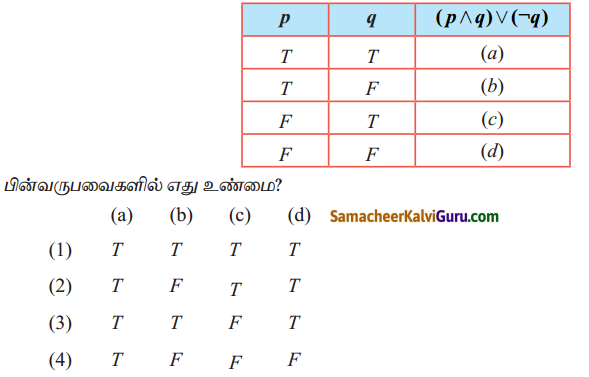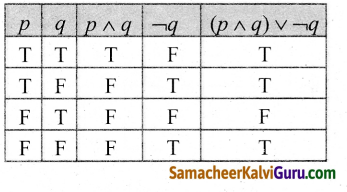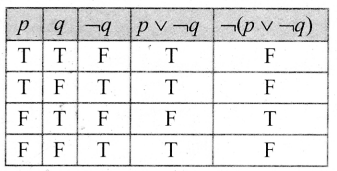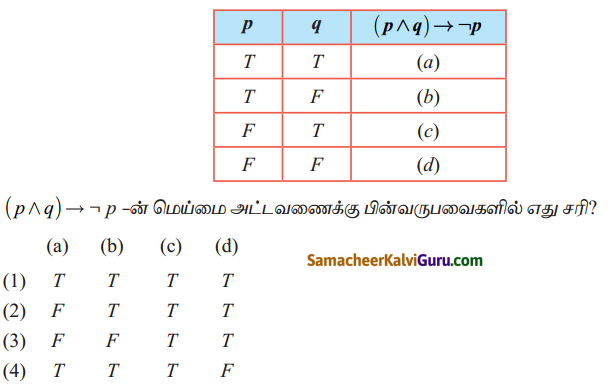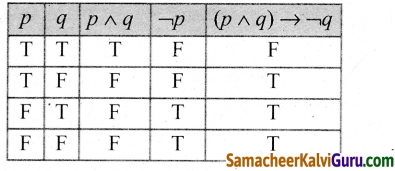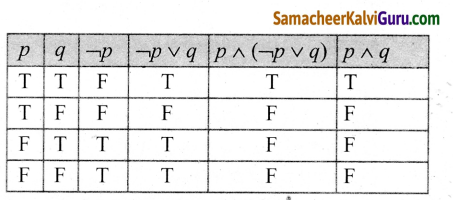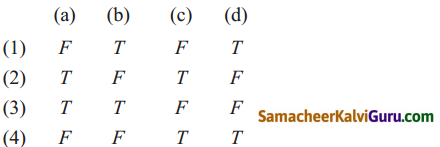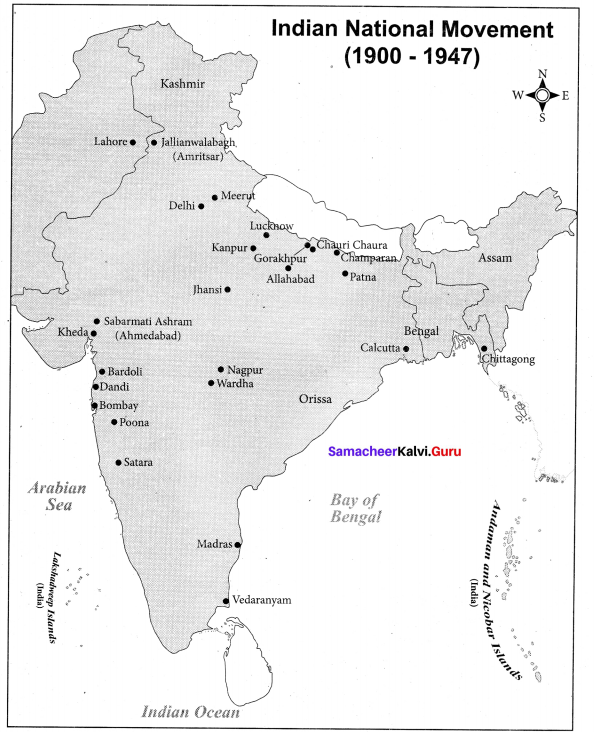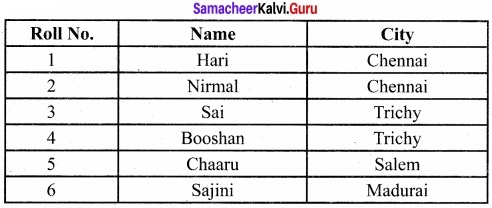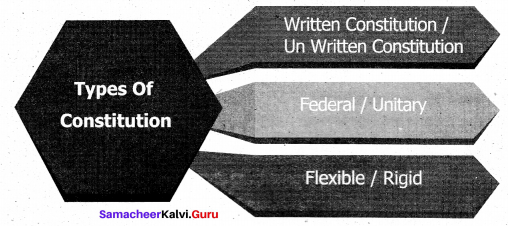Tamilnadu State Board New Syllabus Samacheer Kalvi 12th Maths Guide Pdf Chapter 12 தனிநிலைக் கணிதம் Ex 12.1 Textbook Questions and Answers, Notes.
TN Board 12th Maths Solutions Chapter 12 தனிநிலைக் கணிதம் Ex 12.1
கேள்வி 1.
கீழே கொடுக்கப்பட்டுள்ள கணங்களின் மீது வரையறுக்கப்பட்டிருக்கும் * ஓர் ஈருறுப்புச் செயலியா எனத் தீர்மானிக்க .
(i) ℝ-ன் மீது a * b = a . |b|
(ii) A = {1, 2, 3, 4, 5} – ன் மீது a * 5 = (a, b) -ல் சிறியது.
(iii) ℝ -ன் மீது (a*b) = a \(\sqrt{b}\)
தீர்வு:
(i) ℝ -ன் மீது a = a . |b|
கொடுக்கப்பட்ட ℝ -ன் மீது a* b = a • |b| a, b ∈ ℝ என்க
பிறகு a * b = a. |b| ∈ ℝ.
ஆதலால் a • |b| = ab, b> 0 எனில்
= -ab, b < 0 எனில்
∴ a * (b) = a . |b| ∈ ℝ
ஆம் * ஆனது ℝ-ன் மீதான ஓர் ஈருறுப்புச் செயலி ஆகும்.
![]()
(ii) A = {1, 2, 3, 4, 5} – ன் மீது a * b = (a, b) -ல் சிறியது.
a, b ∈ A என்க
பிறகு (a, b) -ல் சிறியது. = a அல்லது b மற்றும் a, b ∈ A
∴ a * b = (a,b)-ல் சிறியது ∈ A
ஆம் * ஆனது ℝ-ன் மீதான ஓர் ஈருறுப்புச் செயலி ஆகும்.
(iii) ℝ -ன் மீது (a * b) = a \(\sqrt{b}\)
a, b = ℝ என்க [∴ குறை எண்களின் வர்க்க மூலம் ℝ-ல் இல்லை]
a * b = a \(\sqrt{b}\) = ℝ, b < 0 எனில்
எனவே* ஆனது ℝ-ன் மீதான ஈருறுப்புச் செயலி அல்ல.
கேள்வி 2.
ℤ -ன் மீது ⓧ என்ற செயலி பின்வருமாறு வரையறுக்கப்பட்டுள்ளது. (m ⓧ n)=mn + nm: ∀m, I n ∈ ℤ. *ஆனது -ன் மீது அடைவுப் பண்பை பெற்றுள்ளதா?
தீர்வு: கொடுக்கப்பட்ட m ⦻ n = mn + nm ∀m, n ∈ ℤ m, n ∈ ℤ என்க .
m = -3, n = 2 எனக் கொள்க.
∴ m ⓧ n = (-3)2 + 2-3
= 9 + \(\frac{1}{8}\) = \(\frac{72+1}{8}\) = \(\frac{73}{8}\) ∉ ℤ
∴ ⓧஆனது, ℤ-ன் மீது அடைவு பெறவில்லை .
கேள்வி 3.
ℝ-ன் மீது * ஆனது (a*b) = a + b + ab – 7 என வரையறுக்கப்பட்டால் * ;ℝ – ன் மீது அடைவு பெற்றுள்ளதா? அவ்வாறெனில், 3 * (\(\frac{-7}{15}\)) காண்க.
தீர்வு:
கொடுக்கப்பட்ட a* b = a + b + ab – 7
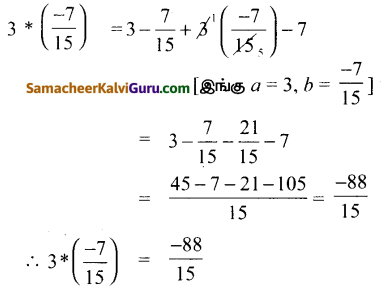
கேள்வி 4.
A = {a + \(\sqrt{5}\) b: a,b ∈ ℤ} என்க. வழக்கமான பெருக்கல் A -ன் மீது ஓர் ஈருறுப்புச் செயல் ஆகுமா என பரிசோதிக்க.
தீர்வு:
கொடுக்கப்பட்ட A = {a + \(\sqrt{5}\)b, a, b ∈ z}
C = a + \(\sqrt{5}\) b என்க
B = c + \(\sqrt{5}\) d ∈ A
இங்கு a, b, c, d ∈ ℤ
∴ C . B = (a + \(\sqrt{5}\) b). (c + \(\sqrt{5}\) d)
= ac + \(\sqrt{5}\) ad + cb \(\sqrt{5}\) + 5bd
= (ac + 5 bd) + \(\sqrt{5}\) (ad + bc) = A [∵ ac + 5 bd ∈ ℤ மற்றும் ad + bc ∈ ℤ]
∴ C. B ∈ A Va, b, c, d, ∈ ℤ
∴ வழக்கமான பெருக்கல் A-ன் மீது ஓர் ஈருறுப்புச் செயலி ஆகும்.
![]()
கேள்வி 5.
(i) *என்ற ஓர் ஈருறுப்புச் செயலி ℚ -ன் மீது பின்வருமாறு வரையறுக்கப் படுகிறது. இந்த * ஆனது, அடைவுப் பண்பு, பரிமாற்றுப் பண்பு . சேர்ப்புப் பண்பு ஆகியவற்றை நிறைவு செய்கிறதா எனச் சோதிக்க
a*b=(\(\frac{a+b}{2}\)); ∀a, b ∈ ℚ.
(ii) *ஆனது, சமனிப் பண்பு மற்றும் எதிர்மறைப் பண்பு ஆகியவை, ℚ -ன் மீது உண்மையாகுமா எனச் சோதிக்க.
a*b=(\(\frac{a+b}{2}\)); ∀ a, b ∈ ℚ
தீர்வு:
கொடுக்கப்பட்ட a* b = \(\frac{a+b}{2}\) ∀a. b ∈ ℚ.
(i) அடைவுப் பண்பு :
a, b ∈ ℚ என்க
∴ a * b = \(\frac{a+b}{2}\) ∈ ℚ
[∵ கூட்டல் மற்றும் பெருக்கல் ℚ-ல் அடைவுப் பண்பு பெற்றுள்ளது]
ℚ-ல் * அடைவுப் பண்பு பெற்றுள்ளது.
(ii) பரிமாற்றுப் பண்பு
a, b = ℚ என்க.
பிறகு a * b = \(\frac{a+b}{2}\) = \(\frac{b+a}{2}\) = b * a
∴ a * b = b * a ∀a, b ∈ ℚ
∴ Qஇல் * பரிமாற்றுப் பண்புடையதாகும்.
சேர்ப்புப் பண்பு
a, b, c ∈ ℚ என்க
a * (b * c) = (a * b) * c
a = 2, b = 3, c =-5 என்க
∴ a * (b * c) = 2 * (3 * -5)
= 2* (\(\frac{3-5}{2}\))
= 2 * (-1) = \(\frac{2+(-1)}{2}\)
= \(\frac{1}{2}\) …..(1)

(1) மற்றும் (2)லிருந்து, a * (b * c) = (a * b) * c
∴ ℚ இல் * சேர்ப்புப் பண்பு இல்லை.
(ii) கொடுக்கப்பட்ட a * b = \(\frac{a+b}{2}\), இங்கு a, b ∈ ℚ
a, b ∈ ℚ என்க
a * e = e * a = a என்ற உறுப்பை பின்வருமாறு காண வேண்டும்.
a = 5 என்க, பிறகு 5 * e = 5
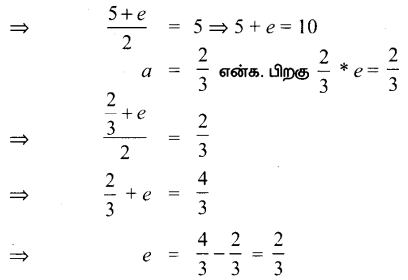
சமனி உறுப்பு ஒவ்வொரு உறுப்புக்கும் மாறுவதால், ℚ-வில் சமனி உறுப்பு இல்லை
∴ * க்கு ℚ -வில் சமனி பண்பு இல்லை .
∴ * க்கு ℚ- வில் எதிர்மறை பண்பு இல்லை .
எனவே சமனி மற்றும் எதிர்மறை பண்பு ஈருறுப்பு செயலி * க்கு இல்லை .
கேள்வி 6.
* என்ற ஈருறுப்புச் செயலி ஆனது A = {a, b, c} என்ற கணத்தின் மீது பரிமாற்று விதிக்கு கட்டுப்பட்டால் பின்வரும் பட்டியலைப் பூர்த்தி செய்க.
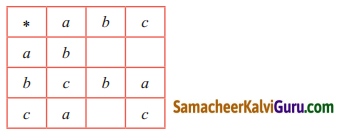
தீர்வு:
A இல் கொடுக்கப்பட்ட * பரிமாற்று பண்புடையது
கொடுக்கப்பட்ட b * a = c ⇒ a * b = c
கொடுக்கப்பட்ட c * a = a ⇒ a * c = a
கொடுக்கப்பட்ட b * c = a ⇒ c * b = a
எனவே
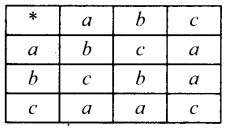
கேள்வி 7.
A = {a, b, c, d} என்ற கணத்தின் மீது * என்ற ஈருறுப்புச் செயலியை பின்வரும் பட்டியலுடன் கருதுக.
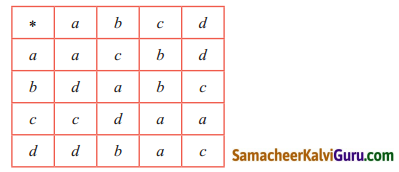
இது மாற்றுப்பண்பு மற்றும் சேர்ப்புப் பண்புகளைப் பெற்றுள்ளதா?
தீர்வு:
கொடுக்கப்பட்ட A = {a, b, c, d} மற்றும் * பின்வருமாறு வரையறுக்கப்படுகிறது.
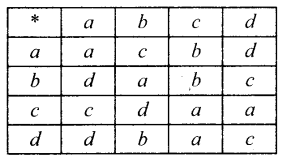
அட்டவணையிலிருந்து
(i) a * b = C மற்றும் ba = d
⇒ A இல் * பரிமாற்று பண்பை பெறவில்லை .
(ii) a * (b * c) = (a * b) * C என்பதை சரிபார்க்க
⇒ a * (b) = c * c
⇒ c # a
∴ A இல் * ஆனது சேர்ப்பு பண்பை நிறைவு செய்யவில்லை.
![]()
கேள்வி 8.
A = \(\left(\begin{array}{llll}
1 & 0 & 1 & 0 \\
0 & 1 & 0 & 1 \\
1 & 0 & 0 & 1
\end{array}\right)\), B = \(\left(\begin{array}{llll}
0 & 1 & 0 & 1 \\
1 & 0 & 1 & 0 \\
1 & 0 & 0 & 1
\end{array}\right)\), C = \(\left(\begin{array}{llll}
1 & 1 & 0 & 1 \\
0 & 1 & 1 & 0 \\
1 & 1 & 1 & 1
\end{array}\right)\) என்பவைகள் ஒரே மாதிரியான வகையினை உடைய ஏதேனும் மூன்று பூலியன் அணிகள் எனில்,
(i) A ∨ B
(ii) A ∧ B
(iii) (A ∨ B) ∧ C
(iv) (A ∧ B)∨C
ஆகியவைகளைக் காண்க.
தீர்வு:
கொடுக்கப்பட்ட A = \(\left(\begin{array}{llll}
1 & 0 & 1 & 0 \\
0 & 1 & 0 & 1 \\
1 & 0 & 0 & 1
\end{array}\right)\),
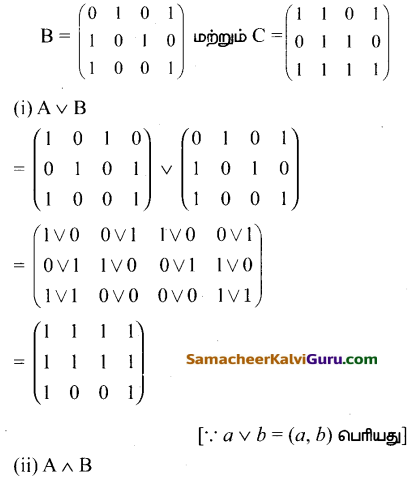
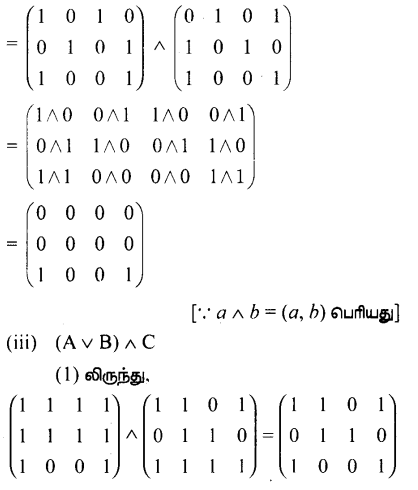
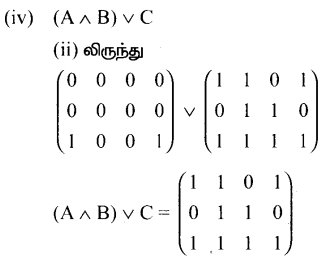
கேள்வி 9.
(i) M = \(\left\{\left(\begin{array}{ll}
x & x \\
x & x
\end{array}\right): x \in \mathbb{R}-\{0\}\right\}\) என்க.
* என்பது அணிப் பெருக்கல் எனக் கொள்க. * ஆனது M-ன் மீது அடைவு பெற்றுள்ளதா எனத் தீர்மானிக்க. அவ்வாறெனில்,
* ஆனது M -ன் மீது பரிமாற்றுப் பண்பு, சேர்ப்புப் பண்புகளையும் நிறைவு செய்யுமா எனச் சோதிக்க.
(ii) M = \(\left\{\left(\begin{array}{ll}
x & x \\
x & x
\end{array}\right): x \in \mathbb{R}-\{0\}\right\}\)* என்பது அணிப் பெருக்கல் எனக் கொள்க.
* ஆனது M -ன் மீது அடைவு பெற்றுள்ளதா எனத் தீர்மானிக்க. அவ்வாறெனில்,
* ஆனது M -ன் மீது சமனிப்பண்பு, மற்றும் எதிர்மறைப் பண்புகளை நிறைவு செய்யுமா எனவும் சோதிக்க. மற்றும் * என்பது அணி பெருக்கல்
தீர்வு:
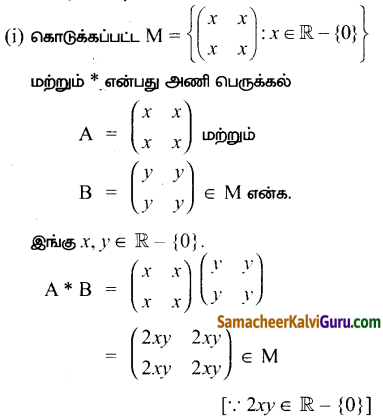
∴ M இல் * ஆனது அடைவுப் பண்புடையது.
பரிமாற்று பண்பு
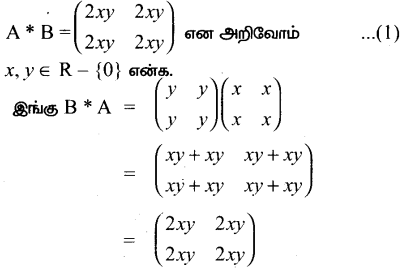
(1) மற்றும் (2) லிருந்து, A * B = B * A
∴ M-ல் *க்கு பரிமாற்றுப் பண்பு உண்டு .
சேர்ப்புப் பண்பு
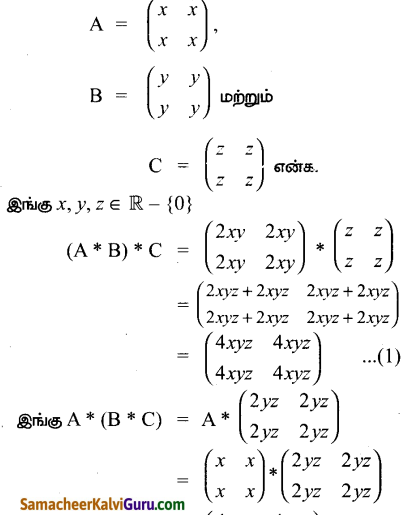
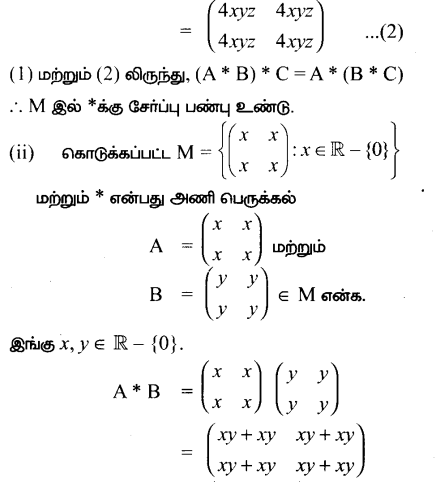

∴ M இல் அடைவுப் பண்பு நிறைவு செய்யப்படுகிறது.
சமனி 2 × 2 அணிகளின் சமனி I = \(\left(\begin{array}{ll}
1 & 0 \\
0 & 1
\end{array}\right)\) ∉ M
∴ M இல் *க்கு சமனி உறுப்பு இல்லை .
எதிர்மறை :
சமனி உறுப்பு இல்லை எனவே எதிர்மறை பண்பும் இல்லை .
![]()
கேள்வி 10.
(i) A = ℚ\{1} என்க. A-ன் மீது* பின்வ ருமாறு வரையறுக்கப்படுகிறது. xy = x + y – xy.
* ஆனது A-ன்மீது அடைவு பெற்றுள்ளதா? அவ்வாறெனில், A-ன் மீது
* ஆனது பரிமாற்று விதி மற்றும் சேர்ப்பு விதிகளை நிறைவு செய்யுமா எனச் சோதிக்க.
(ii) A = Q\{1} என்க. A-ன் மீது * பின்வ ருமாறு வரையறுக்கப்படுகிறது.xy = x + y – xy.
* ஆனது A -ன் மீது அடைவு பெற்றுள்ளதா? அவ்வாறெனில், A-ன் மீது
* ஆனது சமனிப்பண்பு மற்றும் எதிர்மறைப் பண்புகளை நிறைவு செய்யுமா எனச் சோதிக்க.
தீர்வு:
(i) கொடுக்கப்பட்ட A = {Q\ {1}}
x * y = x + y – xy
எனுமாறு A இல் வரையறுக்கப்படுகிறது.
x, y ≠ 1 என்க
∴ x * y = x + y – xy
இங்கு x + y – xy # 1
x + y -.xy = 1 என்க
x + y – xy – 1 = 0
(x – 1) – y(x – 1) = 0
(x – 1) (1 – y) = 0
x = 1 அல்லது y = 1 இது தவறாகும். [∵ x, y # 1]
∴ நமது அனுமானம் தவறு.
∴ x + y – xy # 1
A இல் * ஆனது ஒரு ஈருறுப்புச் செயலி.
பரிமாற்றுப் பண்பு
x, y ∈ A ⇒ x, y # 1 என்க .
∴ x * y = x + y – xy’
மற்றும் y * x = y + x – yx
⇒ x + y = y * x ∀x, y ∈ A .
*க்கு A இல் பரிமாற்றுப் பண்பு உண்டு.
சேர்ப்புப் பண்பு x, y, z ∈ A ⇒ x, y, z + 1 என்க .
கருது (x * y) * z = (x + y – xy) * z
= x + y – xy + z – (x + y – xy)z
= x + y – xy + z – xz – yz +xyz
= x + y + z – xy – yz – zx + xyz ………….. (1)
= x + y + z – yz – x (y + z – yz)
= x + y + z – yz – zy – xz + xyz …..(2)
(1) மற்றும் (2) லிருந்து, (x * y) * z = x * (y * z) A இல் *க்கு சேர்ப்புப் பண்பு உண்டு.
(ii) சமனிப் பண்பு
e ∈ A என்ற உறுப்பை பின்வருமாறு காண வேண்டும்.
a * e = e * a = a
⇒ a + e – ae = a
⇒ e – ae = 0
⇒ e(1 – a) = 0
⇒ e = \(\frac{0}{1-a}\) = 0 ∈ A
* க்கு A இல் சமனி உண்டு .
![]()
எதிர்மறை பண்பு
ஒவ்வொரு a ∈ Aக்கும் a’ ∈ A ஆனது பின்வருமாறு
உள்ள து a * d’ = a’ * a = e
⇒ a + a’ – aa’ = 0 [∵ e = 0]
⇒ a + a'(1 – a) = 0
⇒ a'(1 – a) = -a
a’ = \(\frac{-a}{1-a}\)
நிரூபிக்க \(\frac{-a}{1-a}\) ≠ 1
\(\frac{-a}{1-a}\) = 1 என்க
⇒ -a = 1 – a
⇒ -a – a + a = 1 ⇒ 0 ≠ 1
∴ நமது அனுமானம் தவறு.
⇒ \(\frac{-a}{1-a}\) ≠ 1
∴ x ∈ Aக்கு A இல் எதிர்மறை பண்பு உண்டு.



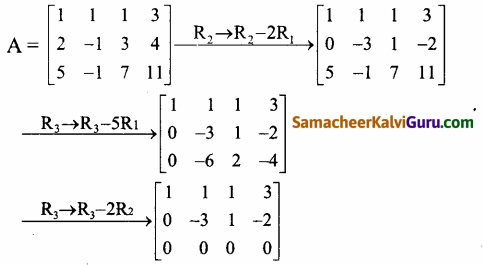
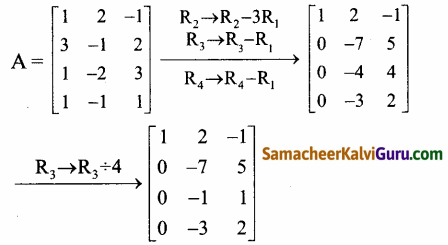
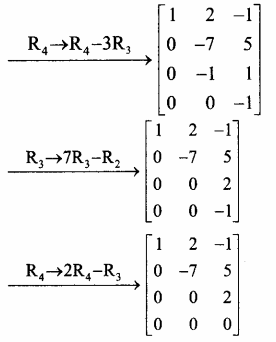
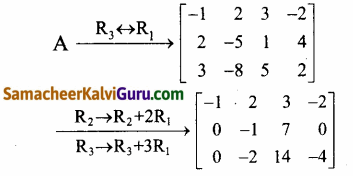
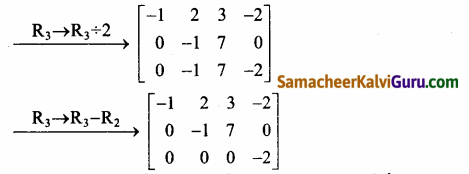

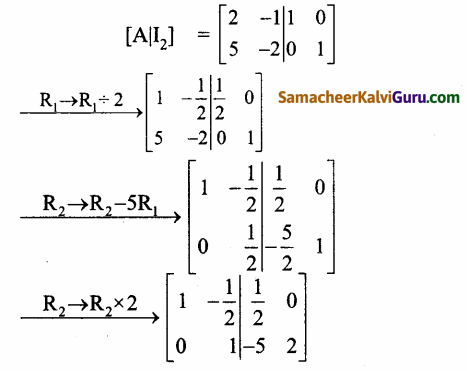
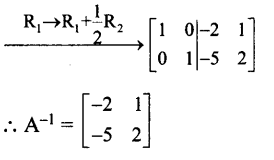
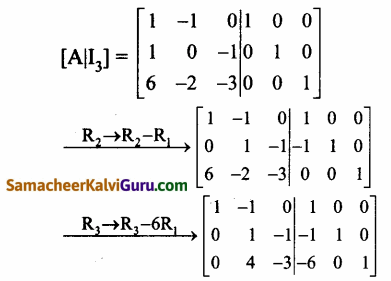
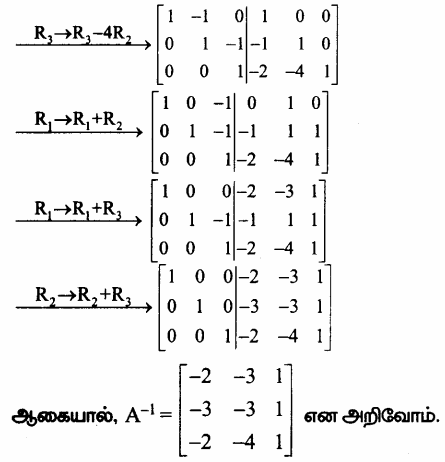

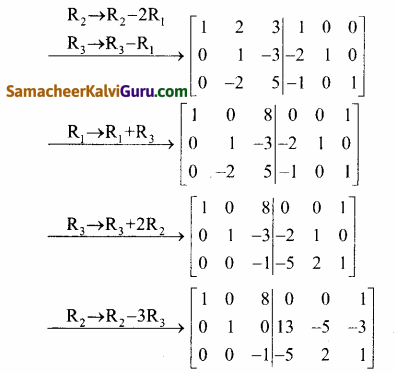
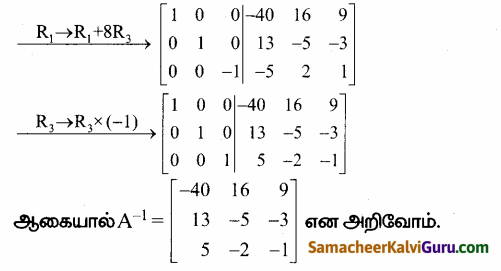

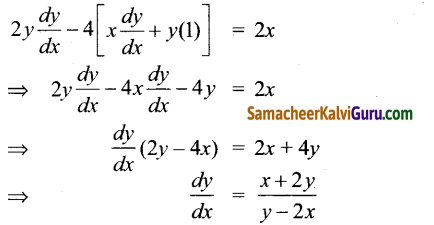
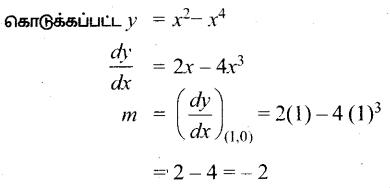
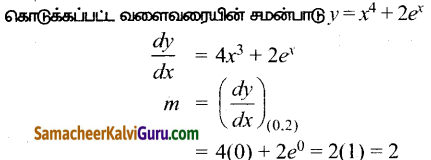
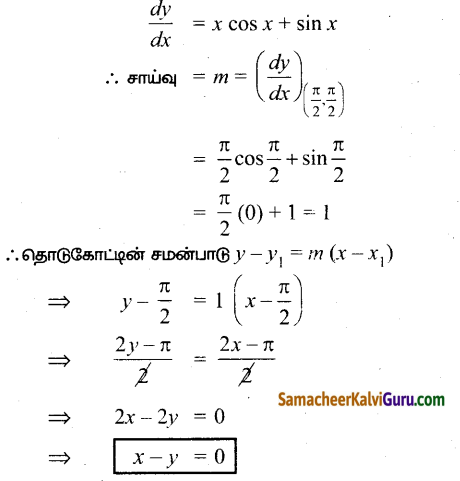
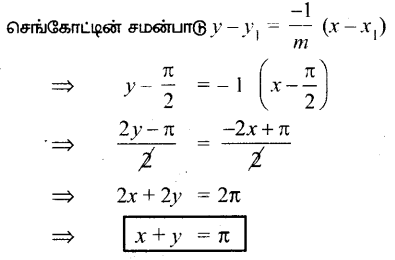
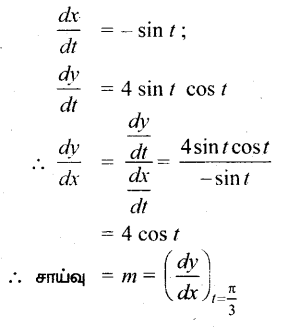
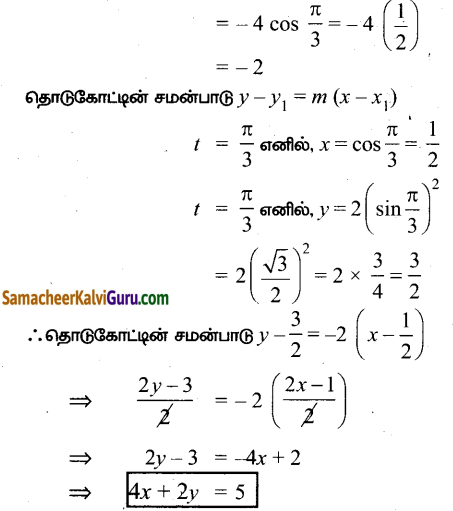
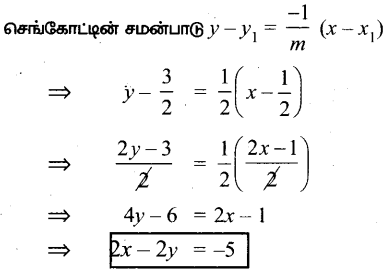

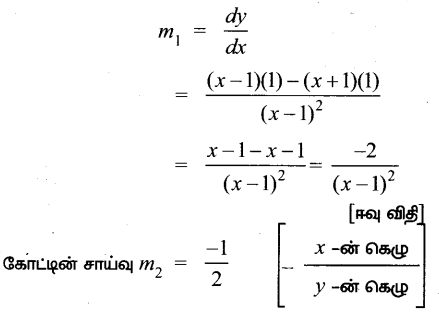
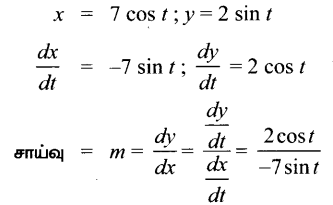
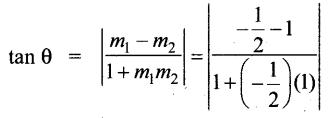
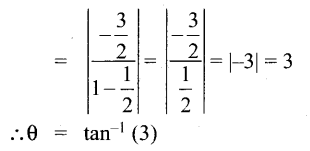
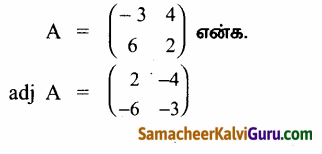
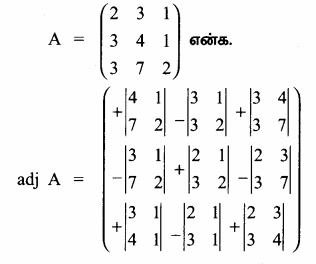
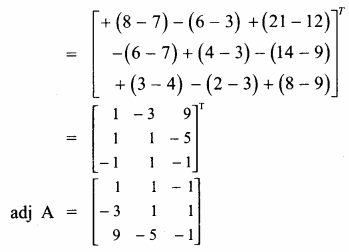
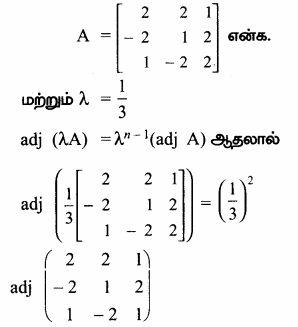
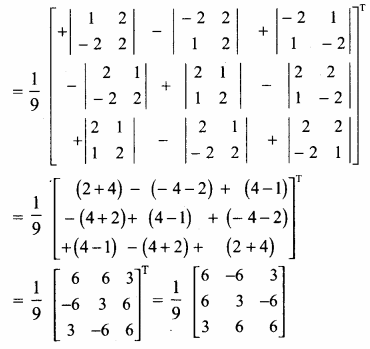
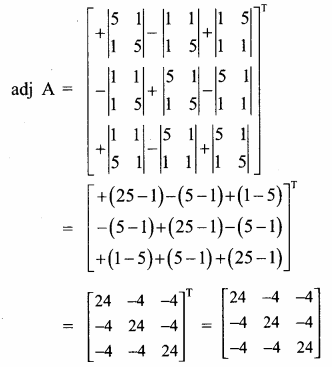
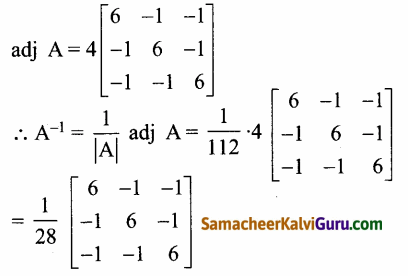

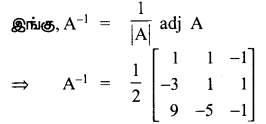
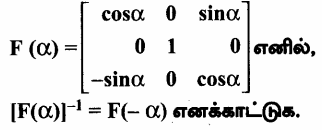
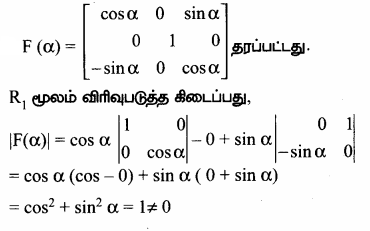
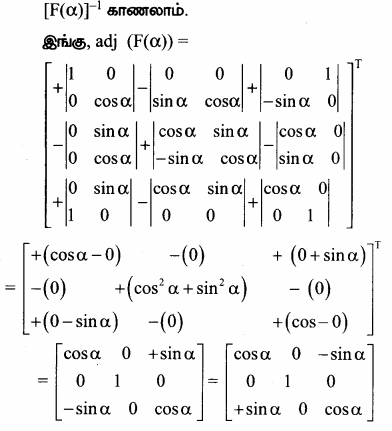
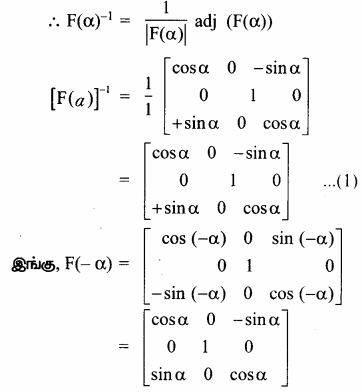
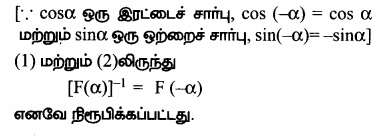

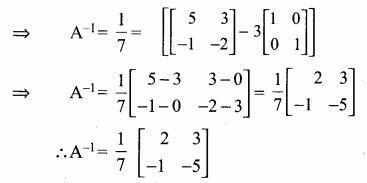

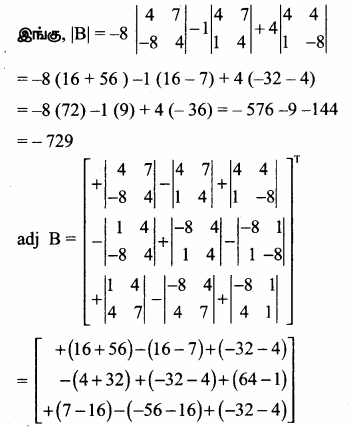
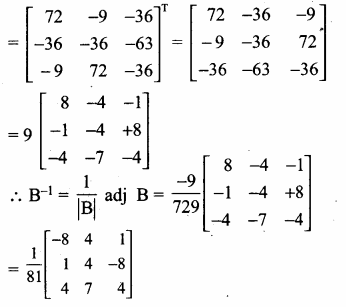

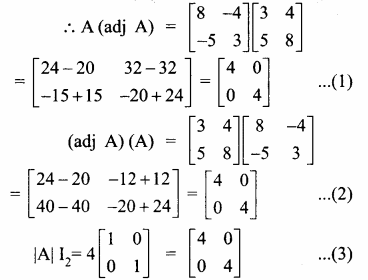

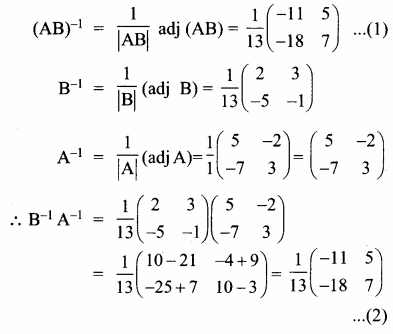
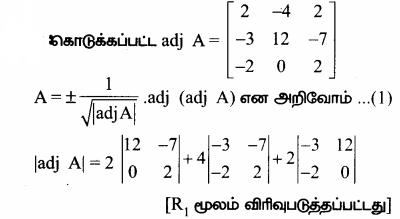
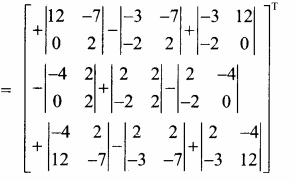
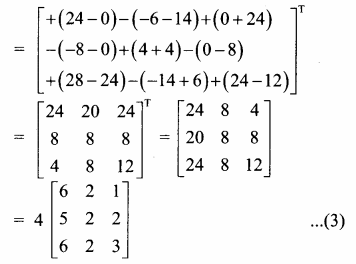

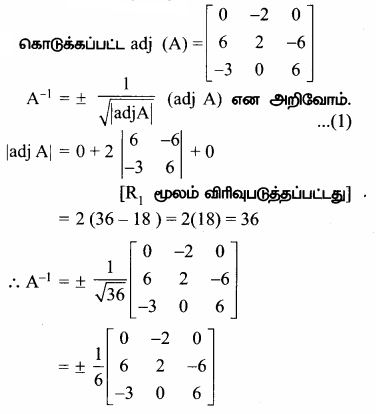

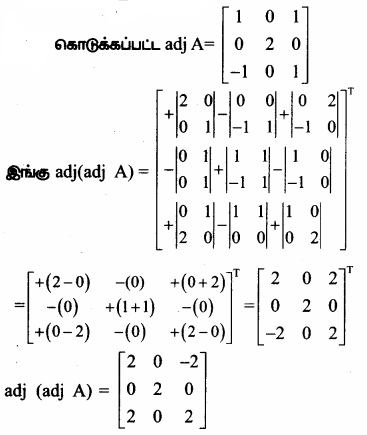
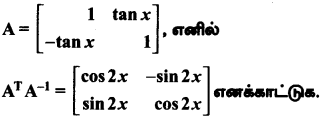

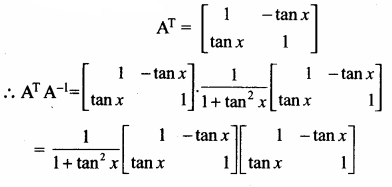
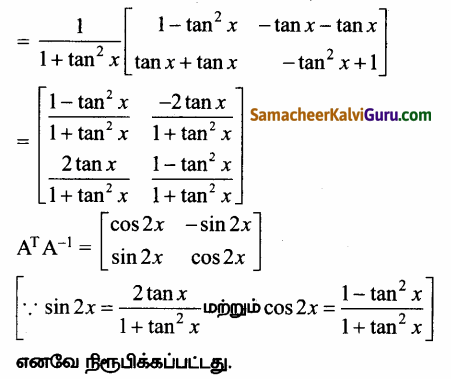
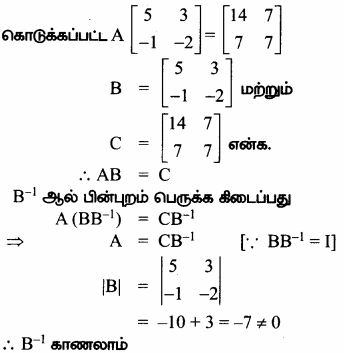
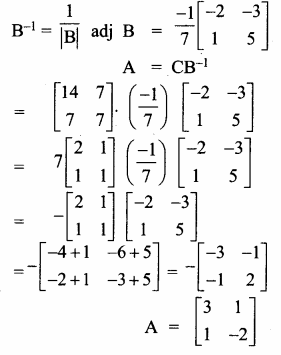
 AXB = C எனில், X என்ற அணியைக் காண்க.
AXB = C எனில், X என்ற அணியைக் காண்க.